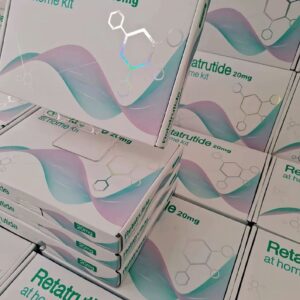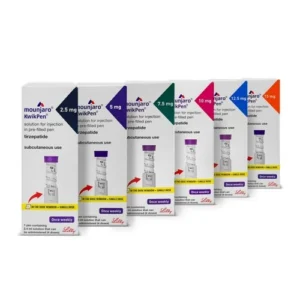Retatrutide Triple Agonist of GLP-1, GIP, and Glucagon: A Breakthrough in Obesity and Diabetes Treatment
Retatrutide Triple Agonist Of, often referred to as the “triple agonist”, is a revolutionary investigational drug developed by Eli Lilly. Unlike traditional medications that target only one or two metabolic pathways, Retatrutide stands out as a triple agonist of GLP-1 (glucagon-like peptide-1), GIP (glucose-dependent insulinotropic polypeptide), and glucagon receptors. This unique mechanism allows it to deliver powerful effects on weight reduction, blood sugar management, and overall metabolic health.
With obesity and type 2 diabetes reaching epidemic levels worldwide, the need for more effective therapies has never been greater. Retatrutide’s ability to target multiple pathways simultaneously makes it one of the most promising treatments currently under clinical investigation.
How Retatrutide Triple Agonist of Works: The Triple Agonist Mechanism
The true innovation of Retatrutide Triple Agonist Of lies in its triple-receptor activation. Each receptor it targets plays a distinct yet complementary role in weight and glucose regulation:
-
GLP-1 (Glucagon-Like Peptide-1):
-
Slows gastric emptying, helping patients feel full longer.
-
Reduces appetite and food cravings.
-
Enhances insulin secretion after meals, lowering blood sugar.
-
-
GIP (Glucose-Dependent Insulinotropic Polypeptide):
-
Improves the body’s insulin response.
-
Supports healthy fat metabolism.
-
Complements the effects of GLP-1 for stronger appetite regulation.
-
-
Glucagon:
-
Increases energy expenditure.
-
Stimulates fat breakdown, promoting weight loss.
-
Helps balance blood sugar and metabolism.
-
By combining these three mechanisms, Retatrutide achieves a synergistic effect—something no single-hormone therapy has been able to deliver as effectively.
Clinical Trial Results: Why Retatrutide Triple Agonist of is Generating Buzz
Preliminary clinical trial data for Retatrutide Triple Agonist Of has been groundbreaking. Some of the most notable findings include:
-
Weight Loss:
Participants without diabetes experienced over 24% body weight reduction in 48 weeks at the highest dose. By comparison, most existing GLP-1 drugs produce between 10–15% weight loss. -
Diabetes Management:
Patients with type 2 diabetes saw improvements in HbA1c, reduced fasting glucose levels, and enhanced insulin sensitivity. -
Cardiometabolic Benefits:
Trials showed reductions in waist circumference, blood pressure, and triglycerides—key markers of metabolic syndrome. -
Liver Health:
Early evidence suggests Retatrutide Triple Agonist Of may also help resolve fatty liver disease (NAFLD), further extending its potential benefits.
These results position Retatrutide Triple Agonist of as a game-changing therapy, rivaling and potentially surpassing current leaders like semaglutide (Ozempic, Wegovy) and tirzepatide (Mounjaro).
Potential Advantages Over Current Therapies
Retatrutide triple agonist of mechanism offers several key advantages compared to existing weight-loss and diabetes medications:
-
Greater Weight Loss Potential: Up to 24% reduction in body weight, significantly higher than other therapies.
-
Multi-Pathway Approach: Tackles appetite, fat metabolism, and energy expenditure simultaneously.
-
Metabolic Health Improvements: Goes beyond weight loss by addressing cardiovascular, liver, and glycemic health.
-
Sustainability: Long-term benefits suggest better maintenance of results compared to diet and lifestyle changes alone.
This makes Retatrutide Triple Agonist of not just a weight loss drug, but a comprehensive metabolic therapy.
Safety Profile and Side Effects of Retatrutide Triple Agonist of
As with most drugs in this class, the most commonly reported side effects in clinical trials were gastrointestinal, including:
-
Nausea
-
Vomiting
-
Diarrhea
-
Abdominal discomfort
These side effects were generally mild to moderate and tended to improve over time as the body adjusted. Importantly, Retatrutide has not shown major unexpected safety concerns so far, though further studies are required to confirm long-term safety.
Current Regulatory Status
At present, Retatrutide is still investigational and not yet FDA-approved. It is available only through clinical trials, where ongoing research is assessing its long-term safety, efficacy, and potential use cases.
Given the outstanding results so far, many experts predict Retatrutide could become one of the most significant advances in obesity and diabetes treatment in the coming decade.
Who Could Benefit from Retatrutide?
If approved, Retatrutide Triple Agonist of could provide a powerful new option for:
-
Adults with obesity (BMI ≥30) who struggle with weight management.
-
Overweight individuals (BMI ≥27) with related health conditions such as type 2 diabetes, hypertension, or fatty liver disease.
-
Patients with type 2 diabetes who need improved blood sugar control beyond diet, exercise, or other medications.
-
Individuals with metabolic syndrome who require comprehensive metabolic improvement.
By addressing multiple aspects of metabolic dysfunction, Retatrutide could help millions worldwide achieve better health outcomes.
Conclusion: A New Frontier in Metabolic Medicine
Retatrutide, the triple agonist of GLP-1, GIP, and glucagon receptors, represents a revolutionary step forward in the fight against obesity, type 2 diabetes, and metabolic disorders. By combining appetite suppression, enhanced insulin secretion, and increased energy expenditure, it delivers unmatched results in clinical trials—helping patients lose significant weight and improve overall metabolic health.
Although it remains under investigation, Retatrutide’s potential to transform obesity and diabetes management is clear. As research continues, this groundbreaking therapy could soon become a cornerstone of modern metabolic medicine, offering hope and healing to millions of people worldwide.






Reviews
There are no reviews yet.